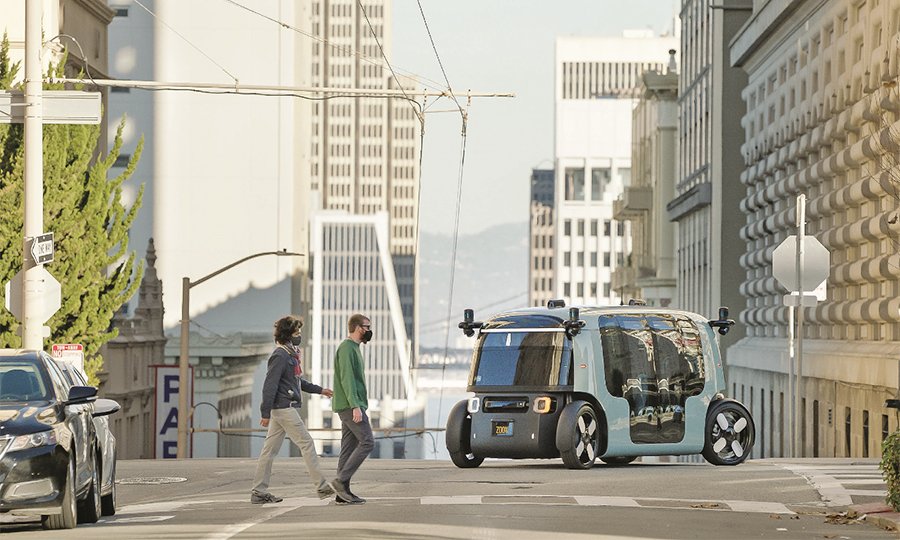<!–*/ */ /*–>*/
| Robotaxi company Zoox details safety innovations in AV ‘transparency’ initiative |

In its second publicly released safety report, Zoox Inc. is offering details about nine of the more than 100 proprietary safety features not found in conventional vehicles that the company is using to further its self-driving vision.
The technologies include rider protection in the vehicle.
The self-driving startup, owned by e-commerce giant Amazon, released the report Tuesday, after it revealed its electric, “purpose-built,” autonomous robotaxi in December. Zoox says it expects to release additional reports, including information on its collision avoidance, external lighting and sound and emergency vehicle-detection systems, as well as information on its vehicles’ structural energy absorbers that dampen impacts from collisions.
“You want to build trust for AVs, you need data, you need transparency and you need experience,” Mark Rosekind, chief safety innovation officer at Zoox, told Automotive News. “A lot of people complain that [reports are] more marketing than a safety report. But I like to highlight there’s so many surveys that show people don’t really understand these new technologies.”
Rosekind, who was NHTSA administrator from 2014 to 2017, said anything that starts to educate the public and policymakers on AVs is “worthwhile.”
In Tuesday’s report, the company highlighted the vehicle’s shorter stopping distances — made possible with independent, antilock braking and active suspension systems — four-wheel steering and bidirectional capabilities.
“There’s nothing esoteric about being able to stop faster and be more accurate in steering,” Rosekind said. “It’s a chance to be very concrete about what it means to bring more safety to the road.”
The company’s robotaxis have redundant steering and driving controls — notably, two batteries, two powertrains and two electronic control units to manage braking — to eliminate single points of failure.
Zoox also detailed five next-generation airbags that accommodate the vehicle’s less traditional features.
“We have to make it very transparent, visible to people: How are we going to create that safe mobility system for you?” Rosekind said. “That’s what this report’s going to help do — get us closer to showing people what the path looks like.”
— Alexa St. John
What you need to know
Volvo’s electric XC90 to include lidar as standard equipment Volvo Cars plans to make lidar sensors standard equipment in a new generation of its XC90 large crossover next year as part of a strategy to deploy more advanced safety and automated-driving technology that relies on precise images of the world around the vehicle. Volvo’s decision to fold lidar sensors into the base price of its vehicle is a bet that customers will pay for the additional capability. It has been called a “watershed moment” by some in the industry. Luminar Technologies Inc. will supply the automaker with its Iris lidar and Sentinel software, which will be used in combination with software from Volvo in the electric XC90 that will be built in South Carolina and go on sale in 2022, the companies said.
Amazon snaps up option to buy stake in self-driving truck startup Plus Amazon.com Inc. has placed an order for 1,000 autonomous driving systems from self-driving truck technology startup Plus and has acquired the option to buy a stake of as much as 20 percent, Plus said in a regulatory filing. Amazon has the right to buy preferred shares of Plus via a warrant at a price of roughly 46.6 cents per share, the filing shows. That amounts to a roughly 20 percent stake based on Plus’ shares outstanding before its planned merger with special purpose acquisition company Hennessy Capital Investment Corp. V.
Roundup
Renault-Nissan alliance invests in Chinese self-driving startup WeRide.
Audi’s move to become an all-EV brand excludes China.
General Motors and Royal Dutch Shell Plc are teaming up in the U.S. to expand EV charging and household energy plans that draw on renewable resources.
VW’s Diess sees autonomy transforming cars more than electrification.
Velodyne exec explains how mounted lidar could help cities move safely.
Jaguar’s new electric-only range of cars will start at about $140,000, Jaguar Land Rover CEO Thierry Bollore told a British publication.
Self-driving truck tech company Embark to go public with $614 million SPAC deal.
What’s happening with Tesla’s $7 billion German factory?
Motional said it will be launching nuPlan, an expanded public dataset created to help self-driving system efficiency and safety.
“Lordstown Motors should pull the plug on the current version of the Endurance electric pickup and reconfigure the drivetrain,” Automotive News engineering reporter Richard Truett writes.
Baidu taps BAIC to mass-produce EVs.
Brain food
Like many catchy ideas on the path to electromobility, the self-contained EV skateboard chassis is stumbling as it meets the hard reality of going from vision to vehicle development and manufacturing, Bloomberg reports.
Last mile
Oshkosh Defense said Tuesday that it will build next-generation U.S. Postal Service delivery vehicles in Spartanburg, S.C., and expects to hire more than 1,000 employees to do so. Ford Motor Co., meanwhile, said it will provide engines, transmissions and other parts for the vehicles.

